
Streaming music service Spotify has such an air of mystery in the U.S. that even a glimpse of the program’s interface draws in readers. For the past year, we’ve discussed again and again when the company would make its way overseas and now the New York Post reports that the popular European company is “finally crossing the pond.”
“After trying to crack the US market for more than a year, Spotify is close to a deal with one major music company in the US and has gained the support of at least one other,” reports the Post. But is it too little, too late?
Of all the things we write about. Spotify is certainly the most inaccessible to most of our readers. From all tales (including those of us who may or may not access the service via proxy server), the service is killer. It’s like having access to a ridiculously huge music collection with all of your friends’ playlists and recommendations, wherever you are, for free. Does this sound too good to be true? It does to the music labels too, though a launch date of Q3 2010 and early 2011 was predicted last March.
When Spotify CEO Daniel Ek spoke at SXSW last year, the buzz on the street was a U.S.-launch announcement. Instead, U.S.-based music aficionados have been left to look toward alternatives like Slacker Radio, Pandora, MOG, Rdio, Napster and others.
The post quotes an anonymous “music executive” as saying that “Spotify is launching in the U.S., for sure. They’ve got the deals now.” While these other services have gained traction, Spotify currently offers something that none of them do – an “all-you-can-eat” music service that costs nothing except for your time. That is, the free service contains ads and users can pay $10 a month to get rid of advertising.
By comparison, the free version of Pandora, which does not let you choose precisely what you want to hear, but rather a customized channel of streaming music, also has ads as well as a monthly time limit. All-you-can-eat services like MOG and Napster, on the other hand, have no free version. It’s pay or go away.
The big question here, then, is whether or not Spotify will be allowed to come to the U.S. with this type of functionality still in place. If not, we’re not sure that there is much of a difference between Spotify and other “all-you-can-eat” services, which generally offer access at $5 for home access and $10 for mobile.
The Post explains that labels are urging the company to stress a subscription model, instead, and make upfront payments estimated to exceed $100 million.
If we get European-style Spotify, expect things to be shaken up quite a bit. If not? It’ll be the same as usual, just with one more option.










